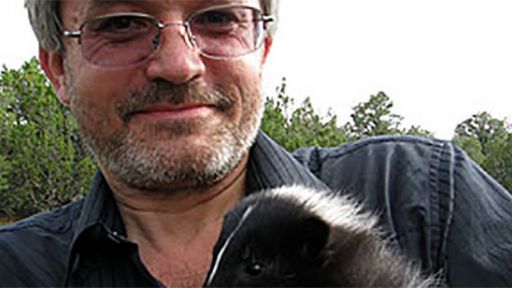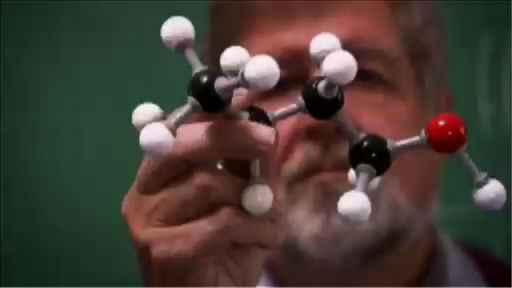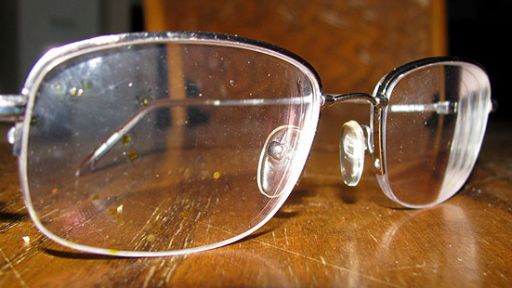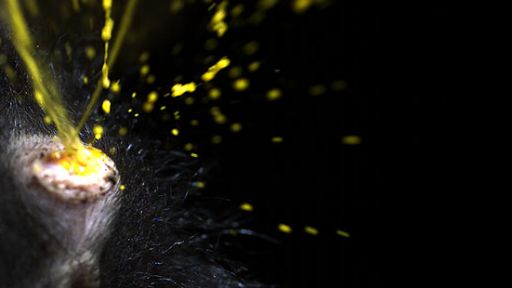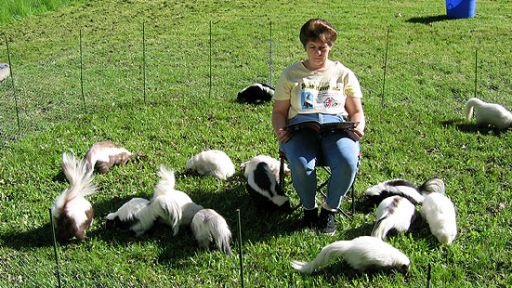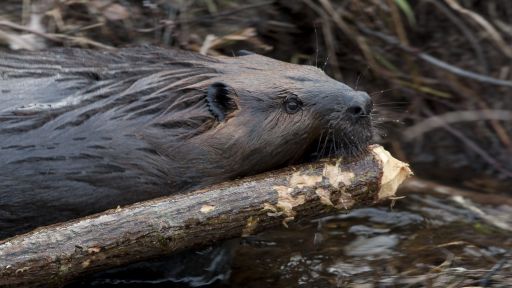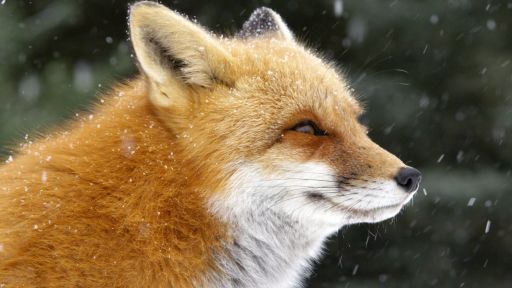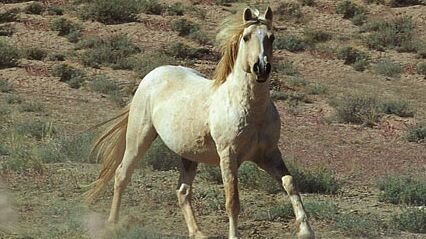TRANSCRIPT
[slow music] - [Narrator] In nature one animal makes a very memorable mark.
- Well it's pretty pungent.
Heavy.
- It is putrid, you know, it doesn't go away.
- It was pretty bad.
- [Narrator] Meeting it may be a close encounter of the less than kind.
- You always knew when someone had hit a skunk.
- [Narrator] Has one of our most recognizable creatures long been misunderstood?
- I love skunks.
I just think they're so funny.
- [Narrator] Perhaps beneath they're simple coats of black and white lies something more than scavengers of the night.
[roaring] - [Narrator] One man makes his home their sanctuary.
- This is a Thumbelina.
We didn't feel like she would make it in the wild.
- [Narrator] Others make them their pets.
- Would you believe there's 18 skunks in this room?
- [Narrator] So maybe it's time for a whole new attitude when we ask is that skunk?
[slow music] - [Announcer] This program was made possible by The Corporation for Public Broadcasting and by contributions to your PBS station from viewers like you.
Thank you.
- [Narrator] One creature of the night may need a PR makeover.
- A friend of mine called me because she was hearing a noise from underneath her house and it was this scratching, scratching sound.
- [Narrator] It makes itself right at home.
- Maybe it's the neighbor's cat that got trapped.
So we go down and I take one of the vents off and I'm like, Come on, it's okay.
You can come on out, you can come on out.
And I see this movement and I'm like, Keep coming, keep coming.
And it's a skunk.
- One of them sprayed my little dachshund.
He thought that it was a friend and it was not a friend.
- They're critters and you don't wanna mess with them because they might have rabies.
- My little sister and I were just out running around and there it was.
Sprayed me in the face, ran home and my parents told me, Do not come in the house.
- [Narrator] It seems everyone has a skunk story, but how much do we really know about them?
It's not as if they're beckoning us to get closer.
Who's the real creature behind this black and white exterior?
What are the secrets of the animal that brandishes nature's worst stink bomb?
At least one man thinks the pew in skunks reputation is a bad rap.
Near Albuquerque, New Mexico evolutionary biologist, Jerry Dragoo runs a kind of halfway house for rescued or relocated skunks.
Striped skunks are the most frequent guests at Dragoo's place.
- This is Thumbelina.
She's a striped skunk.
One of the 12 species of skunks that occur worldwide.
This is probably the most recognized mammal in North America.
When people think of skunks, this is the species they think of.
We kept Thumbelina because we didn't feel like she would make it in the wild.
She likes to have a warm lap to sleep on.
And so if we're sitting on the couch, she will often crawl up and join us.
Likes to eat whatever we're eating.
Also likes to eat while we're not eating.
Thumbelina right now is my best girl.
- [Narrator] Sometimes Dragoo gets one of the more unusual species like Rosebud.
- You're looking pretty.
This is a hog-nosed skunk.
She's a little over 15 years old.
The oldest recorded hog-nosed skunk that I'm aware of.
These claws are very long and they're used for digging.
They're very good diggers and the nose is used for routing out insects.
- [Narrator] Another rarity here is the tiny spotted skunk.
- His name is Pete.
He was in somebody's house.
They actually caught him in a cat carrier.
So I went and picked it up and I looked into the carrier and I saw was a spotted skunk and I was all excited.
I said, Oh, there is a spotted skunk.
You don't see many of those.
And the people that were just kind of going no big deal to them, they could care less.
They just wanted it outta their house.
- [Narrator] Seldom scene spotted skunks are the most secretive members of the family and the only ones to hunt and forage in trees.
Today a new striped skunk, a pregnant female joins the other guests on Dragoo's two acre compound.
- [Dragoo] This female that we had to relocate was under somebody's house.
- [Narrator] He removed her from the yard of a fearful neighbor.
- She was out doing what skunks do and got into the wrong place.
But fortunately, the homeowners didn't want her euthanized.
So they got ahold of me and we brought her out here and taking care of her.
She had already gone through breeding but hadn't given birth yet.
And one of our concerns was that we put her out into a new environment and she wouldn't be able to find a home and take care of a whole nest of babies.
So we wanted to hold on to her until after she had the babies.
Let her care for those at a really safe place and give her a good safe home here.
- [Narrator] Becoming a skunk researcher wasn't Dragoo's boyhood dream, but in science you don't always get your first choice of study subject.
- When I was first getting started, I was interested in mustelids.
Those are things like weasels, otters, wolverines.
And my advisor said, I've got a question about skunks.
And I said, Well that's not exactly mustelid I was thinking of.
So he sent me down to the southwestern part of the state and knowing how bad these things are supposed to smell, I meticulously covered it up and started processing things.
Stood up suddenly and had these droplets all across the front of my shirt, all across my field notes.
I looked up to see if it was raining and I looked at the skunk and he had both ends pointed at me.
His back end and his front end were looking straight at me.
It was like, Well this ain't so bad.
I couldn't understand what everybody was all upset about.
When I got back to work three days later, they wouldn't let me in the building.
[door slams] I have no sense of smell, at least for skunks that I'm aware of.
- [Narrator] Born for the job.
Dragoo began investigating where skunks fit in the tree of life.
He collected DNA from almost every skunk species, but his first analysis defied conventional wisdom.
It looked as if skunks were not members of the weasel family.
- Well I thought I was doing something wrong.
So I started my whole research over again and came to the same conclusion.
Skunks really weren't mustelids.
- [Narrator] Pop goes the weasel theory.
- Chromosomes were different, proteins were different.
- [Narrator] Dragoo realized that skunks make up their own special family of carnivores.
A new branch dubbed Mephitidae after a word meaning stink.
Striped skunks are as widespread as any North American mammal.
In part that's because they're not shy of humans.
Calm and confident, with stink weapon locked and loaded, they can adapt to almost any environment and they've found some pretty surprising havens.
One of them is Martha's Vineyard.
This Massachusetts island is a playground for the rich and famous and also for the black and white.
- They often know we're coming before we'll see them, but if the wind is just right and the waves are creating a lot of noise you can sort of get close to them, pretty close to them.
- Closer than you would like then you like.
- Than you would like to.
You don't want to get one caught between you and the water.
I've had moments when I've come off this beach at two or four o'clock in the morning and I go, Is that a human being?
Now I'm really seeing things.
And it's Luanne doing her skunk thing.
- [Narrator] Luanne Johnson has been investigating the secret lives of the island's skunks.
- I think I had a perception that skunks were kind of slow moving dopey animals you know, not very smart or you know didn't have a whole lot going on.
They were just out there kind of hoovering things up on the landscape.
- [Narrator] Having put radio collars on some 50 skunks in the course of her study, Johnson tunes in the skunk channel almost every spring and summer night.
- [Luanne] I can get a pretty good idea of where they are, what they're doing.
- [Narrator] This skunk has detected Johnson.
It tries to warn her off by raising its tail.
If Johnson continues to approach, she may get spritzed.
Like all skunk researchers, she's paid her dues.
- It's a very strong odor.
If you get in your eyes, it certainly burns quite a bit.
So I can understand why predators avoid skunks after being sprayed in the face myself.
- [Narrator] After five seasons in the field, Johnson has a detailed account of a night in the life of a skunk.
Skunks cover a surprising amount of ground.
As much as three miles a night in search of food.
She also discovered that skunks can have nine or more different dens.
Katie, for example, slept in this series of dens over the course of 16 days.
- They have dens all over the landscape.
They know where they are, they can find them.
They seem to be able to carry pretty extensive maps in their heads of their territories and that's amazing to me.
- [Narrator] Skunks sometimes share dens in the winter to conserve heat by snuggling.
But usually the most crowded boroughs are those of mothers with babies.
This new mom has six helpless kits.
The babies are born with black and white markings on their naked skin that are soon covered with fur of the same pattern.
At the age of four weeks, they open their eyes for the first time.
In another three weeks or so, around the time of weaning, mom will lead them on their first trip out of the den.
This mother seldom leaves her kits alone.
That's because if a male enters the den, even the dad, he's likely to kill her babies.
Jerry Dragoo's pregnant female has given birth.
- [Dragoo] What a good girl you are.
Yeah, you're being really good.
- [Narrator] And she and her new kits are doing well.
- [Dragoo] You get a few of them in there, don't you?
- [Narrator] But not all baby skunks are so lucky.
- [Dragoo] We're coming down.
- [Narrator] Another litter lost their mother at a very young age.
Dragoo picked them up from New Mexico Game and Fish.
For these six week old orphans he's acting in loco parentis.
- [Dragoo] Okay.
- [Narrator] But many would call him just plain loco.
- Okay, who wants to be first?
Come on.
When we got them they were hungry, they were being fed cat food.
Cats require a lot more protein in their diet than skunks do.
And a lot of people, for some reason seem to to think skunks and cats are closely related, but really they're not.
So we switched them over to the puppy formula real quick.
Your teeth are starting to come in.
Yeah.
There you go.
That's what you're looking for.
- [Narrator] The babies are born ready to spray.
- They don't have quite as much oil.
So it's more kind of a poof rather than a liquid.
You'll get the same odor but it just doesn't last with these guys.
- [Narrator] The kits won't start eating solid food for another couple of weeks.
- There you go.
There you go.
Come on.
You see the female's got a lot of white on her tail.
And then these two males, they've got a little white tip on their end.
And this guy, I call him Blackie cause he doesn't have a white tip.
- [Narrator] With 30 to 80 skunk guests a year.
Dragoo finds it challenging to get on a first name basis with all of them.
- Let's go this way.
Come on.
We just run outta names.
You can't call them all Flower or Stinky or Pepe.
Come on, sweetie.
There you go.
- [Narrator] Dragoo will release these four orphans as soon as they can fend for themselves.
With instinctual hunting and foraging skills these fast growing creatures pursue one of the most eclectic diets in the animal kingdom.
Calm and confident, they set about eating anything that moves and a lot of things that don't.
And on their rounds, they must hold their own when they meet other animals with potent weapons of their own.
[rattlesnake rattles] Skunks are known to attack snakes.
When this rattler smells what's passing by, it recognizes a threat and goes silent to avoid detection.
In a direct confrontation, it's the rattlesnake that is likely to lose.
Skunks have a taste for spicy fair.
Striped skunks know that if they scratch at a beehive, they can pick off the bees one by one.
[bees buzzing] Fur protects the skunk's skin, but no one knows how it tolerates stings to its tongue.
Striped skunks are one of the few animals that eat stink bugs.
When spooked this beetle releases an acerin chemical from its rear.
Takes one to know one.
This hungry skunk rolls the insect in the sand until its stink tank is empty.
A hog-nosed skunk sometimes hunts in one of nature's smelliest environments, a bat cave.
It picks off unlucky babies that have fallen to the floor.
Skunks are highly resourceful.
They'll even swim to seek a better meal on another shore.
But it's likely by boat that they came to Martha's Vineyard in the 1960s as pets.
They thrive because of their wide ranging diet.
Skunks favor ecotones, places where two different habitats come together.
Where marsh meets dune or sand meets berry patch nature offers a smorgasbord.
And an exceptionally rich ecotone is where land meets sea.
- It surprised me how much natural food they do find on the beach.
I was amazed that they really do spend a tremendous amount of time just in that inner tidal zone, eating all those little sand fleas and mole crabs and such.
- [Narrator] But not all ecotones are natural.
Human beings create borders with their almost every construction.
A road, a house, a lawn.
And skunks are flexible enough to hunt and forage in these margins.
By shadowing us, they thrive.
Welcome to Marysville, California.
A typical city with an average human footprint.
It has an above average skunk population.
- If you go up and down North Beale Road, you can get that fragrance.
- I have no idea how many skunks are here.
- I have a skunk living underneath my store here.
- Everybody who lives in this town seems to have at least one skunk story.
- The paper is normally delivered anywhere from 4 to 5:30 in the morning, and I have come down to go get the paper.
You bend down to get the paper and you're looking, you know, face to face with one.
- Growing up here, I never really noticed that there were so many skunks until I became a police officer here.
We were getting a high volume of complaints actually where we're headed now in downtown on First Street.
[voice on radio speaking] [calm music] - There's one.
Right there.
We just saw two skunks within a half a block in the downtown area.
- [Narrator] Marysville skunks might be just a curiosity, except for one feature of the city.
Located in the heart of California's flood prone Central Valley, Marysville is protected by seven miles of earth and levees.
This boundary traps that special smell and it also makes good skunk habitat.
Given that a levee's job is to keep water back the last thing you want in one is a hole, like a skunk den.
- That is definitely a concern, a real safety concern here.
- [Narrator] If water rushed into this small hole, it could widen into a dangerous fisher.
Marysville is now pushing back against the skunk invasion.
- Part of my job is to make sure that the town is safe from high water.
- [Narrator] If city workers suspect a hole is occupied, they'll call animal control to remove the critter.
Next comes a dramatic step.
The habitat must be made skunk unfriendly.
Levee superintendent Frank Miller, directs a controlled burn.
- Today we put in for roughly two acres.
The fire will rush through so quickly it won't even scar, you know, a plastic can or a bottle that's there.
It's not like they're very hostile type animals.
In sixth grade, I actually made a ceramic skunk.
I called it Skippy.
I do like skunks, but my job is to keep boring animals out of the levees.
So that's mainly what we gotta do.
It's nothing against the animal.
- [Narrator] Now it's time to plug the dikes.
- [Miller] Visually we're looking for mounds.
Big mounds of dirt.
- [Narrator] Miller fills in the boroughs.
If the skunks return, they'll find an unappealing neighborhood and what might feel like a padlock door.
They'll likely just move to another one of their dens off the levee.
For the citizens of Marysville, it's only a partial solution because something besides the levees is drawing in the skunks.
And until Marysville figures out what it is, the skunks may change addresses, but they'll keep the same zip code.
While residents here might have the sense that skunks are quick on the draw.
Experts know that a skunk sprays only as a last resort.
It packs no more than four tablespoons of its precious bodily fluid, and it can take time to replenish empty glands.
So skunks have an array of tactics to avoid confrontations.
The vivid stripes help an enemy remember its first skunk encounter.
Spray me once, shame on you.
Spray me twice, shame on me.
In a tense encounter, a skunk will often first try backing off.
- Their first response is gonna be to run away.
And if they turn around and face you, a lot of times they'll get into a defensive posture and they will get down really low and they'll lift their front feet and just stamp really hard.
- [Narrator] This skunk charges a rival but fumbles its prize in the process.
When a conflict is imminent, the striped skunk hoists a warning flag.
The spotted skunk is more flamboyant and the stripes seem to add a few intimidating pounds.
It can even spray from this unlikely position.
Conscious of its power, Charles Darwin wrote of the skunk "It roams about the open camp and fears neither dogs nor men."
Add to that one of North America's most fearsome predators, the mountain lion.
[roaring] - [Narrator] Threats are usually enough to keep enemies at bay, including coyotes.
Only when a skunk is surprised or senses its out of options will it make the ultimate decision.
Ready.
Aim.
To fire, the skunk extrudes a pair of nozzles from its rear.
- And you can see those stick out past the anal sphincter when they're getting ready to spray.
They can use those to target and they'll direct their spray in whatever direction they want to go.
- [Narrator] And it's a semiautomatic weapon.
- I was actually sprayed by one animal nine times in 11 seconds.
90 minutes later, he sprayed me again three times.
- [Narrator] To understand the skunks recipe for success, Dragoo sent samples of the spray to William Wood at Humboldt State University.
From an organic chemist's point of view, skunk spray ingredients have an interesting characteristic.
- It will ignite if you light it.
They're highly flammable.
- [Narrator] But of course the skunk didn't evolve the flame thrower, it evolved a chemical weapon.
Wood discovered new molecules in the spray, including ethyl.
A sulfur based compound found in garlic and onions.
- The human nose is fantastically receptive to molecules of this type.
They're odoriferous, and in high concentrations it can cause people to vomit.
[fast music] - [Narrator] A skunk doesn't know when its anal glands are empty, so it raises its tail and threatens to spray as if fully loaded.
Would you call this bluff?
One of skunks few predators doesn't care if a skunk is bluffing or packing stink.
The great horned owl has little sense of smell.
One other threat to skunks also couldn't care less about the spray.
Cars are the leading cause of skunk deaths.
- They rely so heavily on those scent glands they're usually not concerned that anything's really gonna bother them.
The skunks may be on the side of the road forging or getting ready to cross, a big car comes along at a high speed.
They're likely just to put their tail up and spray.
Rather than running away, they'll get hit by a vehicle.
- [Narrator] If a skunk is struck, it will be gone, but not easily forgotten.
- We're driving down the road and right in front of us-- - You always knew when someone had hit a skunk.
- The whole thing sprayed all over our car.
- Because it went on for miles and miles and miles.
- Well, it's pretty pungent.
Heavy.
- It's putrid, you know, it doesn't go away.
- It just, it was so bad.
- It was pretty bad.
- [Narrator] It's a serious situation when man's best friend gets a dose of the world's worst smell.
Tomato juice only masks the problem and the coverup is only temporary.
Some components take time to break down.
William Wood has figured out how to neutralize the stink.
In your yard, never inside, mix a quart of 3% hydrogen peroxide, a quarter cup of baking soda and a teaspoon of detergent.
This liquid, which should be mixed up fresh because dangerous pressure can build, breaks down the thiol.
Keep this concoction away from your dog's eyes.
After five minutes, rinse with water.
Now, hope your dog is not a repeat offender.
Wood and his students know, from chemical analysis and their own noses, that striped and spotted skunks have distinct spray recipes.
- Yeah, this one's a little spicier.
- Okay.
Yeah.
I feel like-- I kinda feel like that one's more stronger than that one.
- I'd like to say one smells sweeter almost.
- This one smells nicer.
[laughing] - The down and out on the skunk scents.
This one's a little bit more pungent, we're feeling.
And the spotted skunk is a little bit sweeter.
- [Narrator] How did skunks get their spray in the first place?
- These glands are the same glands that we see in all carnivores.
Dogs have them, cats have them.
All these animals you hear about them making scent marks.
That's what these glands are used for.
Now with skunks, they've taken it to an extreme and they use it as a defense mechanism that they will spray on any potential predator.
- [Narrator] Wolverines like many land carnivores spread secretion from anal glands to mark territory.
In animals such as mink, the liquid evolved repellent qualities.
- Some carnivores evolved the skill of spraying rather than smearing.
But only the skunk family has raised the anal spray to an art.
With a knee weakening stink and pointable nozzles.
- Nipples that you find on the scent glance of skunks mean that they're nipples instead of ducts.
They have a lot more control on how they spray.
If they want to squirt out a stream, it's just like a water hose.
You open up the nozzle full wide and it comes out as a stream.
But if you try to push the same volume through a smaller opening, it actually comes out as a mist.
So they can control how that actually sprays.
If they can see their target, it usually comes out as a stream and it's directed right at the face.
If they know there's something chasing them but they can't really see it, they can send it out as a mist.
And so you get these little atomized droplets that take a while to fall down and a predator will usually have to run through that.
And that's usually enough to deter them.
They actually have to think about firing their spray.
- [Narrator] Dragoo is now ready to release some of his charges.
In this sparsely populated high desert a striped skunk found under someone's shed will soon find around one square mile it can call home.
It doesn't even mind sharing its range with other skunks.
- We've played this game before.
You need to go ahead and run.
[fast music] - [Narrator] A spotted skunk found eating dog food in someone's kitchen is more reluctant to leave.
Freedom or free lunch?
[fast music] - We may or may not ever see him again.
But somewhere down the line, we will see their offspring.
Here we go.
Escape.
- [Narrator] As for the four orphans, they aren't yet hearing the call of the wild.
- [Dragoo] What is that?
It's dirt.
- [Narrator] Now 12 weeks old, they are bright eyed but cautious.
They cleave to Dragoo as they would to their mother.
- [Dragoo] You okay?
- [Narrator] Still the outing is good practice.
They need to get familiar with their future home.
In most other places, it's illegal to relocate skunks into the wild.
That's because people link skunks with a dreaded disease.
Rabies.
- A lot of people think that all skunks have rabies or that they're born with rabies and that's just not true.
Skunks are like any other mammal.
They have to be exposed to the virus before they can shed it.
- [Narrator] Of rabid, wild animals in North America, skunks come in number two, behind raccoons.
In the US, the last reported case of rabies transmitted by a skunk was in 1981.
On Martha's Vineyard, Luanne Johnson is monitoring the health of wild skunks.
The first step is to trap them.
- So that's where I'm headed down there and I can can see the skunk is awake.
There we go.
Hi Violet.
Good morning.
You crabby this morning?
- [Narrator] Before conducting her exam, Johnson must give Violet a short-lived sedative.
- [Luanne] Why don't we get this over with Violet?
Yeah, let's get this over with.
Yeah, sorry about that.
- [Narrator] Johnson is discovering that it's the little things that can do in skunks like Violet.
- When a skunk gets debilitated with something like distemper or rabies, they get really lethargic and they stop doing their normal grooming and then they'll get covered in ticks and eventually it's the ticks that are what finish them off.
You'll find a stunk this size and she'll have 150 bloated ticks all over her and she'll have, you know, her gums won't have any pink left at all.
They'll be white cause she's basically being bled to death.
Okay.
There you go, Violet.
She's waking up.
- [Narrator] Fear of diseases, including rabies, is why many states outlaws skunks as pets.
Ohio is an exception.
At Skunk Haven near Cleveland.
Deb Cipriani cares for skunks given up by frustrated pet owners.
- When people adopt skunks, they want babies or they want a skunk that's the perfect pet that goes in the litter box, comes when you call it sits on your lap.
And they don't wanna bother with medical issues.
So that's why we have a lot of skunks.
- Most of Cipriani's fosters skunks are domestic varieties.
Their scent glands have been removed.
- Great.
- [Narrator] Bred as pets since the 1950s, domestic skunks come in colors that only an aficionado can discern.
- Come on, Pearl.
You have lavender, apricot, champagne, mahogany, different color shades of gray, smoked.
You will not see one of those colors running around in the wild.
- [Narrator] Cipriani has come to embrace the low key personalities of these unsung creatures.
- Would you believe there's 18 skunks in this room?
You don't see them, do you?
You can hear them stomping though.
My friends thought I was nuts taking in skunks.
Come on, mamas, babas.
But once they got to meet the skunks and interact with the skunks.
Come on, babas.
They accepted it.
What do you guys think that is?
- [Narrator] Convinced that to know skunks both domestic and wild is to love them, Cipriani has begun to spread the good word to her community.
- This is a spotted skunk.
He is four years old.
His name is Sparky.
- [Narrator] In turn, Cipriani's neighbors come to her with all of their skunk related issues.
- We get phone calls every day with people calling.
I have a skunk in my yard.
I have a skunk in my porch.
I have a skunk under my shed.
What do I do?
My suggestion is get a radio.
They don't like bass music.
Aim it down towards dusk.
Not during the day.
And eventually the skunk will move on.
Yes.
- How loud do they scream?
- They go like [imitating skunk screaming] really loud.
- [Narrator] Cipriani ends her show with something even better than pulling a rabbit out of a hat.
- I put the skunk that I'm holding away and I pull the skunk out from my pouch.
Explain the name and where I got her.
- [Kids] Wow!
- Her name is Iris.
- [Kids] Aww.
- Usually the back end is facing the audience and she's been sitting there this whole time.
And believe it or not, this is a wild skunk.
She is fully loaded.
[laughing] And this is to teach you guys that skunks do not spray just like that.
- Okay, I'm on this end.
Wait a minute.
[laughing] - [Cipriani] Move back this way.
He's soft, isn't he?
- [Kid] Yes he is.
Feel the difference?
You like it?
- Yeah.
- Did you have fun?
- [Kid] Yeah.
- Good.
If somebody comes to my home to adopt a skunk, I ask them certain questions.
They have to have a vet willing to care for the skunk.
Hi guys.
How's it going?
They have to cater to the skunk.
They have to be patient.
That way.
We'll put her down.
- [Narrator] Good homes are hard to find.
Many families come calling.
Few are chosen.
The Wallace family is meeting Phoebe a descented skunk whose first owners had to give her up.
- She's all right.
- [Narrator] They are promising candidates.
They've owned a skunk before.
- Their personalities are really interesting.
They're very independent.
Very we're not gonna do what you say.
If they want something, they're gonna find a way to get to it.
- The first skunk that we had opened our refrigerator when he was eight weeks old and dragged a head of cabbage all the way through our apartment.
So that's when we knew we were challenged.
- He found a crack in the paneling got out in the rest of the basement and emptied about 10 flower pots because he wanted to see what was at the bottom of the flower pots.
He was pretty much the center of our lives for six years.
I would say they're not for everyone.
You'll get as much out of it as the amount of time you're willing to put into it.
She has no special needs.
- She's just a little overweight.
- Oh well.
[laughing] - Run of the mill at our house.
- [Narrator] For this domestic skunk, a warm family is in his future.
Elsewhere, wild skunks just aren't feeling the love.
But there's something about Marysville.
Skunks are still throng in downtown despite the burning of the levees.
One citizen has become a self-styled private eye trying to figure out what's attracting the skunks.
Lucky Owyang's tools, a small still camera and his wits.
- It's my nature and my habit, following, you know, the trek of the skunks every night.
This skunk was just walking right along the wall and straight at me.
It did not have any fear.
It had its tail raised up and I didn't know what to make of it.
- [Narrator] After nights of staring danger in the face and in the rear, a lucky strike.
Owyang started to notice a pattern.
Where there were skunks, there were also cats.
Not only that, the two species were palling around around.
- I've heard stories of the cats in the area playing with the skunks.
They're apparently very friendly.
- We have a a feral cat problem here in this end of town.
People just dumping cats off.
- There are very friendly doorsteps where people leave out cat food and those are regularly frequented by the skunks in town.
- You have people who, they're animal lovers misguided in some ways because what they'll do is they actually set out feeding trays for the cats.
- My neighbor was setting out food and he was even putting food in front of his door.
Cat food.
The skunks knew they had a little banquet every night.
- [Narrator] As the cat food theory spread change came to Marysville.
- The police have really tried to discourage people feeding feral cats here.
- Eventually we were able to change their behavior enough that the end result was that the skunks stopped coming around.
We're down to maybe like one or two a night.
- [Narrator] As Marysville residents embrace the idea that even small acts can make big ripples in the natural world, they can step back and actually enjoy their striped neighbors.
- Their movements have a lot of personality.
I love skunks.
I just think they're so funny.
You know, they look like a cartoon.
- [Narrator] Back in New Mexico, Jerry Dragoo prepares to say farewell to the four orphans who have considered him their mother for the past eight weeks.
- Okay guys, it's time.
Oh, come on out.
Come on out.
There you go.
There you go.
Come on out.
- [Narrator] 14 Weeks old and nearly full sized.
The orphans are still playful, but it's time to grow up.
Dragoo is no longer the center of their universe.
They're gaining confidence in their unique power.
Three of the youngsters seize the moment.
They don't look back.
But one is reluctant to part.
No matter how we try to keep them at a distance, skunks will find a way to close the gap.
Clever and curious, their talent is to exploit the margins that we create.
But skunks don't threaten us.
Wafting that unmistakable scent, they simply follow in our footsteps.
Humble denizens of the undergrowth just trying to get along in an increasingly human world.
[slow music] - [Announcer] This program was made possible by the Corporation for Public Broadcasting and by contributions to your PBS station from viewers like you.
Thank you.
[slow music]

